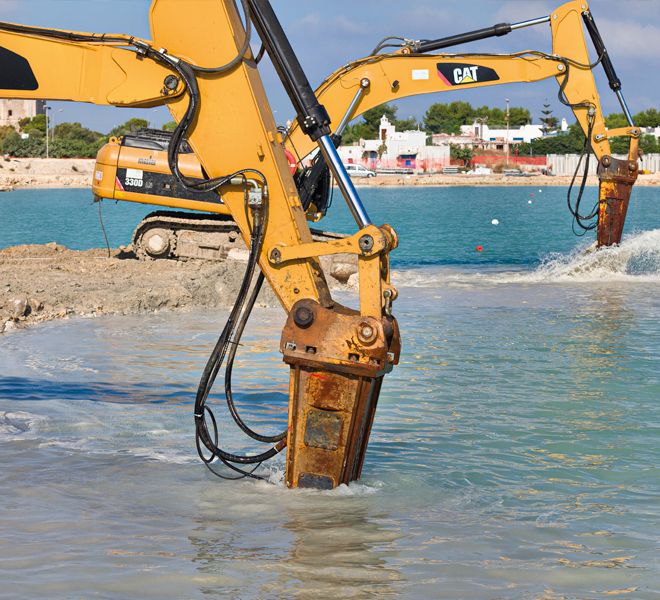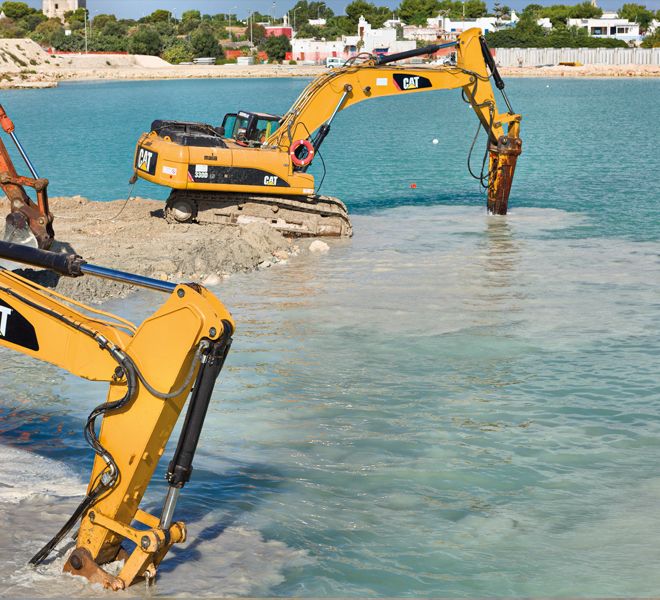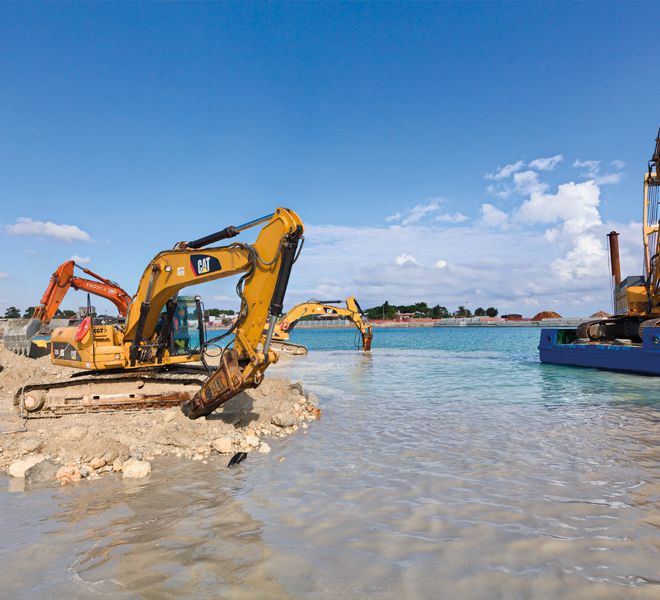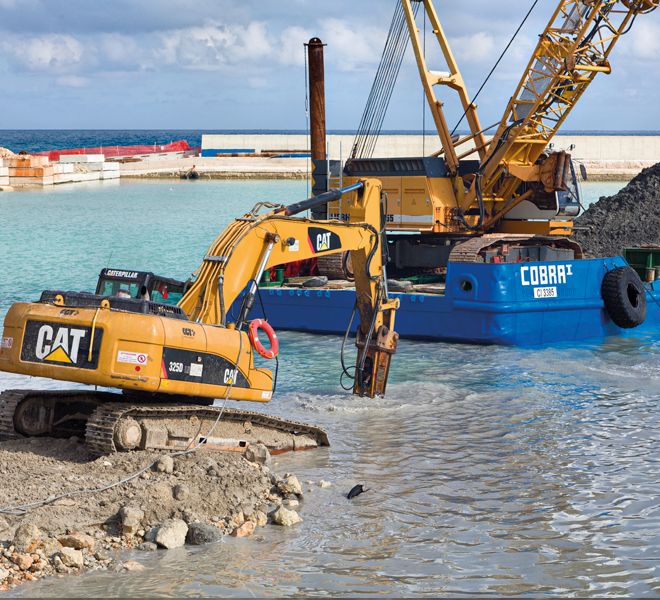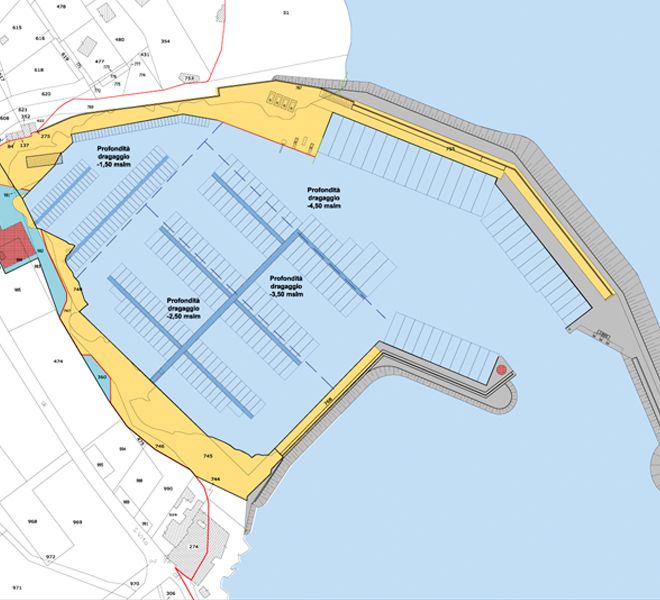Two large Indeco breakers on a submarine mission
A strategic mission entrusted to two Indeco breakers: one HP 5000 and one HP 7000 owned by Trani firm Scavi SaS, mounted on a CAT 325D and on a CAT 330D, respectively
Large Indeco breakers are expected to work with total precision and care, even when used under extreme conditions such as the underwater excavation works for a new marina in Polignano a Mare, near Bari.
The objective and the project
In an area known as Cala Ponte, just outside Polignano a Mare, between two massive sea walls is a harbour that has been almost totally abandoned since the early 1970s. It has remained virtually unused mainly because of some rocky shoals inside the harbour that needed excavation.
The port completion project, which includes creating a yacht marina is a key part of the tourism recovery plan which is being vigorously promoted by the Polignano a Mare town council in conjunction with the nearby towns of Alberobello, Castellana Grotte, Conversano and Monopoli.
In fact, given its considerable historic, cultural and environmental heritage, and excellent climate for most of the year, the coast between Bari and Brindisi has always suffered from a chronic lack of entrepreneurial initiatives in the tourism sector, especially when it comes to pleasure craft. A refurbished harbour would also meet the strong demand for berths along that stretch of coast – the nearby ports of Mola di Bari and Monopoli simply do not have the capacity. It should also be underlined that the improvements to the existing harbour need to be implemented with caution, since this is an area of great natural beauty.
The harbour under current conditions
Polignano a Mare harbour is classified as a port of regional and interregional significance. The area known as Cala Ponte lies about 2 km NW of Polignano, in the suburbs between the town centre (to the south-east) and a tourist and residential area (to the north-west). The port is well-connected with the centre of Polignano and with the nearby SS 16 highway via recently odernised access roads. The existing harbour is made up of a sea wall in two parts, with an overall length of 197 m, and an 85 m long inner quay, creating an entrance channel approximately 110 m in width. The only rudimentary jetties are located along short stretches of the sea wall and inner quay. The harbour and its perimeter are very shallow, with various rocky shoals (formed by the limestone which composes much of the nearby coastline). As regards winds and sea conditions, the harbour is currently particularly exposed to the Scirocco. When this prevailing wind blows hard, the whole harbour becomes unusable. And when the northern Maestrale wind rises, storm surges often break over the top of the sea wall, given that it is only 2.5 metres in height. Also, being 115 m wide, the entrance channel is so broad that the only area properly sheltered from the waves is close to the inner quay, where the water is too shallow for mooring. This exposure to the wind and the sea, combined with the inadequacy of the breakwaters sheltering the harbour, creates very choppy conditions inside the basin, and together with the dangers posed by the shallows and shoals severely curtails use of the harbour, which is viable mainly in summer months and only for small craft. From October to May, when storm surges are more common, the harbour is declared unfit for use.
The new works
The structural alterations involve extending the inner quay and sea wall, improving the entrance channel and accessibility for craft, installing floating pontoons, and changing the design and type of onshore facilities. The harbour will be dredged, thus allowing vessels of various sizes to enter and manoeuvre safely, while additional mooring spaces will also be created.
After dredging, the depth along the stretch between the current harbour entrance and the root of the sea wall will be about 4.5 m; meanwhile, the central stretch will be dredged to 3.5 m; the Eastern portion closest to the inner quayside and the shore to the South will be 2.5 m deep, and finally the western part of the harbour, closest to the shore, and designed for the smallest craft, will be dredges to a depth of just 1.5 m. The dredging will be accompanied by expansion, renovation and construction of new berthing spaces along the inner quay and sea wall.
Dredging, volumes and spoils
The sea bottom at Polignano a Mare harbour is mainly rocky, often with a layer of medium-to-fine grain sand, located mainly in the centre of the harbour and close to the existing entrance channel. The results of geognostic surveys performed in the harbour showed the following breakdown of the type of material for dredging:
1) medium-to-fine grain sandy material on the surface
2) compact limestone. In addition to excavating the rock, the
job involves preliminary removal of the medium-to-fine grain sand; the task needs to be carried out in different parts of the harbour so as to ensure that the depths set out above are achieved.
The fact that the spoils are mainly limestone means they can be re-used. After temporary storage in a nearby area which will serve as the car park in the finished project, most of the limestone will be used as fill when building the new infrastructures (wharfs, quays).
Excavation methods
The sandy materials will be removed
using a trailing suction dredger.
The rock excavation will be carried out
using two Indeco hydraulic breakers,
an HP 5000 mounted on a CAT 325D
and an HP 7000 mounted on a CAT
330D. Approximately 40,000 m3 will be
removed in about 4 months.
Trani Scavi have been using Indeco
breakers for over 25 years, and they
also have an Indeco HP 3000, an HP
500, and an HP 1800.
They use only Indeco breakers.
The site in brief
Main Purchaser
Cala Ponte SpA, Noci, Bari province
Temporary Association of Companies between:
• Cooperativa San Martino
from Chioggia, near Venice – Maritime works contractors
• Trani Scavi SaS
from Trani, near Bari – Excavation contractors
• Valerio General Costruzioni Srl
from Margherita di Savoia, near Foggia – Public and private engineering contractors
Designer and Project Coordinator for Cala Ponte SpA
Giuseppe Lamanna
Technical Works Manager for Cooperativa San Martino
Luca Gallo
Underwater Demolitions Manager for Trani Scavi
Francesco Pertout

